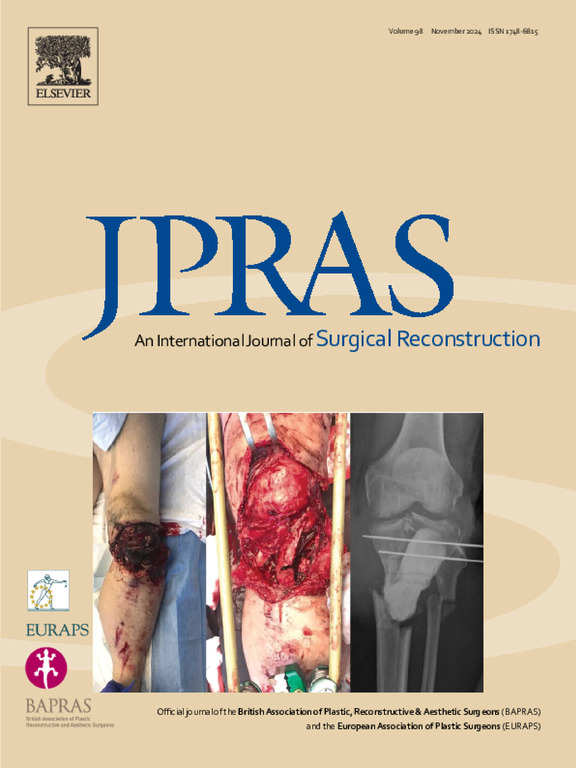Investigating the relationship between sensation and satisfaction in reduction mammaplasty: A systematic review and meta-analysis
IF 2
3区 医学
Q2 SURGERY
Journal of Plastic Reconstructive and Aesthetic Surgery
Pub Date : 2025-03-01
DOI:10.1016/j.bjps.2024.10.028
引用次数: 0
Abstract
Background
Reduction mammaplasties are among the plastic surgery procedures with the highest rates of patient satisfaction. However, the loss of postoperative sensation in the breast and nipple-areolar complex remains a concern. In light of increasing interest in nerve-preservation techniques, we sought to investigate the relationship between retained sensation with overall satisfaction in reduction mammaplasty in current literature.
Methods
The authors systematically reviewed all studies that reported postoperative sensation and satisfaction in patients who underwent reduction mammaplasty, using the MEDLINE, Embase, Cochrane, CINAHL, and Scopus databases in October 2023. Studies were evaluated for methodological quality using an NIH Quality Assessment Tool. Meta-analyses of proportions were conducted.
Results
A total of 48 studies met the eligibility criteria. The median quality assessment score was 8/10. For 28 studies eligible for statistical analysis, random effects pooled proportion for patients that retained preoperative sensation was 0.78 (95% CI: 0.67–0.87), and for patients that report postoperative satisfaction was 0.94 (95% CI: 0.91–0.97). Overall, the studies reported a relatively wide range of sensation outcomes with consistently high satisfaction scores.
Conclusion
The results of this systematic review suggest that other surgical factors (e.g., relief of macromastia symptoms, aesthetic appearance) play a greater role in patient satisfaction compared to sensation retention in reduction mammaplasty. Wide variability in assessment methodologies for both sensation and satisfaction was noted. Standardizing and objectifying measurement techniques, particularly for sensation, will help further characterize the relationship between sensation and satisfaction in future studies.
研究乳房缩小整形术中感觉与满意度之间的关系:系统回顾和荟萃分析。
背景:乳房缩小术是患者满意度最高的整形手术之一。然而,乳房和乳头乳晕复合体术后感觉缺失仍是一个令人担忧的问题。鉴于人们对神经保留技术的兴趣与日俱增,我们试图研究现有文献中保留的感觉与乳房缩小整形术总体满意度之间的关系:作者于 2023 年 10 月使用 MEDLINE、Embase、Cochrane、CINAHL 和 Scopus 数据库,系统地回顾了所有报道乳房缩小整形术患者术后感觉和满意度的研究。研究采用 NIH 质量评估工具对方法学质量进行评估。对比例进行了元分析:共有 48 项研究符合资格标准。质量评估得分的中位数为 8/10。在符合统计分析条件的 28 项研究中,保留术前感觉的患者的随机效应汇总比例为 0.78(95% CI:0.67-0.87),报告术后满意度的患者的随机效应汇总比例为 0.94(95% CI:0.91-0.97)。总体而言,研究报告的感觉结果范围相对较广,满意度评分始终较高:本系统综述的结果表明,与乳房缩小整形术的感觉保持相比,其他手术因素(如巨乳症症状的缓解、外观美观)对患者满意度的影响更大。感觉和满意度的评估方法存在很大差异。标准化和客观化的测量技术,尤其是感觉测量技术,将有助于在未来的研究中进一步确定感觉和满意度之间的关系。
本文章由计算机程序翻译,如有差异,请以英文原文为准。
求助全文
约1分钟内获得全文
求助全文
来源期刊
CiteScore
3.10
自引率
11.10%
发文量
578
审稿时长
3.5 months
期刊介绍:
JPRAS An International Journal of Surgical Reconstruction is one of the world''s leading international journals, covering all the reconstructive and aesthetic aspects of plastic surgery.
The journal presents the latest surgical procedures with audit and outcome studies of new and established techniques in plastic surgery including: cleft lip and palate and other heads and neck surgery, hand surgery, lower limb trauma, burns, skin cancer, breast surgery and aesthetic surgery.

 求助内容:
求助内容: 应助结果提醒方式:
应助结果提醒方式:


